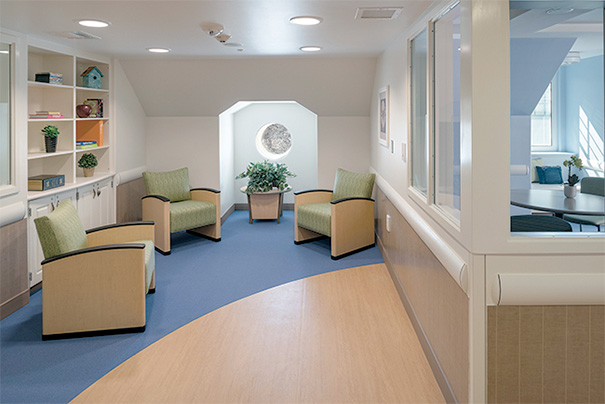 |
|
PHOTO COURTESY OF JSPHOTOGRAPHY This space features built-in bookcases and locked storage areas made from durable, marine-grade, high-density sheets as well as custom-scored wall protection that hides seams and weighted chairs that prevent them from being thrown. |
Health care interior designers are looking to create warm, comfortable and inviting spaces for patients, family members and staff. They take infection control, occupant safety and maintainability into account for every design.
Of course, durability of materials always plays an important factor in any built environment and this is especially true when it comes to a behavioral health setting.
You may also like |
| Behavioral health facility designs |
| Guidelines for behavioral design |
| Creating calmer interior spaces |
| |
Finishes and furnishings in behavioral health environments are subjected to heavy use and abuse that is well-beyond normal wear and tear. Materials need to withstand patients’ slamming doors, kicking walls, throwing furniture or puncturing fabrics. They also must be easily repairable.
A clear understanding
So, what can interior designers do to specify finishes and furnishings that will last without sacrificing the look and feel they are trying to achieve?
First of all, a clear understanding about the nature of patients and their anticipated acuity levels needs to be discussed with caregivers to determine how a space should be approached and understand how abusive each population can be. Only after understanding the needs for each space and patient population should specific products or installation methods be considered.
In addition to researching appropriate products, it is helpful to review the most recent “Design Guide for the Built Environment of Behavioral Health Facilities,” distributed by the Facility Guidelines Institute. Interior designers also should be sure to verify any other regulations with their local authorities having jurisdiction and certification authorities.
Finishes. Much like establishing the needs of each patient type early in the design process, understanding the expectations of product performance early in the project is important to reach the maintenance and life-cycle cost goals for each facility. Points to consider are product composition, product construction and how products are installed, repaired or replaced.
Specifying materials that can withstand abuse and continue to look good is important, but it’s not the only important point to consider. Another important factor is the downtime a facility will require during repairs and replacement. Most facilities don’t have the luxury of shutting down a room or wing and relocating patients during the process, especially in high- traffic areas and group spaces that are used all the time.
In most facilities, a large quantity of drywall typically is used for patching and repairs. However, drywall can be destroyed easily. One solution is to use impact-resistant drywall. In some cases, a double layer of impact-resistant drywall may be used in locations where patients are prone to punching or kicking walls. In extreme cases, a layer of sheet metal securely fastened to the studs before applying the drywall can be used for increased impact resistance.
Even something as common as paint warrants consideration in behavioral health environments. A good alternative to standard latex paint is to use ceramic paint with antimicrobial properties. Ceramic paint has a special composition that creates a smoother finished surface so dirt and stains cannot penetrate as easily. It also is highly scrubbable. Although ceramic paint may have a higher up-front cost compared with that of latex paint, the need to repaint on a regular basis can make this solution more cost-effective over time.
Of course, walls can be protected in other ways, too, and the aesthetics vary with each product type. Many patients try to pick away at materials where seams are visible, so a good installation would be one in which seams are not easily noticed or can be camouflaged within the product. Long lengths of walls cannot always be seamless. A simple solution could be high-impact wall protection, which comes in a variety of patterns and textures, as a wainscot or custom headboard. Edges can be sealed with pick-proof or tamper-resistant sealants to help prevent patients from pulling them away from walls.
Ceilings can be difficult to specify because a hard ceiling deemed safer for some patient types also can make a room very noisy. Acoustical ceilings are designed to help with sound absorption and sound attenuation. However, specific safety considerations need to be taken into account in a behavioral health setting, such as acuity of patients, level of supervision and ceiling height.
Some manufacturers produce secure and tamper-proof acoustical metal ceilings when greater security is needed for more acute patient types. This type of ceiling reduces the potential of patients to store contraband or use metal ceiling grids as a weapon. It also makes the ceiling more resistant to vandalism because it’s more durable.
When it comes to flooring options, there’s an abundance of selections that vary in color and can represent materials such as wood or stone. Short- and long-term aesthetics play a role when specifying flooring, especially because it will be exposed to a lot of abuse. Some patients drag weighted furniture on it, try to pick at it, throw things at it and pound on it. There’s also constant foot traffic, which scuffs floors. Flooring also needs to withstand a number of daily spills that could cause staining or seeping into the sublayer.
A seamless floor, whether it is poured or has welded seams, still appears to be the best application. In addition, an integral cove helps to protect the wall base and keeps liquids from filtering through the seams. Some manufacturers have a carpet that can be welded at the seams with a moisture barrier acting as a seamless floor once installed. A two-part epoxy is an excellent adhesive choice for glued-down flooring applications, because it makes the flooring much more difficult to be removed by a patient. However, it needs to be verified with each manufacturer as to whether it’s suitable.
Another important flooring factor is the wear layer and ease of cleaning. A heavy-duty commercial wear layer should be used. The thicker the wear layer, the more durable the product is. How easily a floor can be cleaned and stains removed is important in any facility. Luckily, there are many more flooring options available now.
Flooring has become much more environmentally friendly, and waxed floors are slowly becoming a thing of the past. Additionally, a highly polished floor that once was considered a clean look is now considered a fall hazard that also may appear wet to aging eyes.
Furnishings. Consulting with facilities managers and clinical staff early in the design process is crucial to understanding the needs of each space, which ultimately dictates how it should be furnished. Furniture should be tested, and what’s stated in the product literature should be evaluated before specifying any furniture pieces.
Finding suitable furniture for each type of behavioral health patient can be a difficult challenge. Furniture must be able to withstand abuse. It is hard to find pieces that are aesthetically pleasing and durable at the same time, but it is not impossible. Some manufacturers who specialize in behavioral health products offer custom solutions or pieces that can be modified.
The construction of each piece of furniture is important. The first step is to find pieces that are well-crafted with durable materials that can be cleaned easily. The next step is to consider safety. Each piece should be inspected closely for any sharp edges, removable panels, metal hooks or anything that could be used as a ligature point. It is imperative to check with manufacturers to make sure that nails are not used in the construction of a furniture piece, even if the nails are not visible when the piece is finished. All bottoms should be finished with tamper-resistant screws and sealed. Fabric or fabric mesh shouldn’t be used as a cover. It also is a good idea to avoid crevices where contraband can be hidden.
For behavioral health, high-performance, commercial-grade fabrics are preferred. These fabrics come in both woven and unwoven styles. Fabrics with moisture barriers; stain-resistant finishes, including graffiti-free fabrics and bleach-cleanable fabrics; and antibacterial and antimicrobial properties now can be specified in fabrics for furniture.
Type of fiber, finish, fire rating, color fastness, cleaning method and the amount of double rubs, as assessed through the standard Wyzenbeek Test, can be found for all commercial-grade fabrics sold in the United States.
Fabrics that exceed 100,000 double rubs is preferred for behavioral health environments. The higher the number of double rubs equates to higher wearability. Fabrics with double rubs of 500,000 or more now can be found on the market.
Small accessories found in upholstered furniture should be inspected carefully. Exterior tags should be removed. Metal vents should not be specified. Zippers must be self-locking and should require a special tool for opening. Designers need to be aware of the construction of each furniture piece and must work with facilities professionals to find the pieces that are adequate.
Furniture can be lightweight for movability, weighted or permanently fixed. The type of furniture will vary per facility, depending on patient needs and space requirements. Legs on freestanding chairs that have sled bases are more appropriate than chairs with four post legs, because post legs can be detached and used in a harmful way. When weighted furniture is required, it should be heavy enough to stop patients from picking pieces up and tossing them.
Any fixed piece of furniture can be augmented with tamper-resistant sealant around the edges. Tall bookcases or built-in wardrobes should have sloped tops to avoid ligature points. Drawers and doors can have ligature points, so facilities may prefer open units with fixed shelves as opposed to drawers and doors. Keeping wardrobes no higher than 36 inches to avoid being used as ladders also may be advised.
For furniture tops, edging that is molded from one piece is preferred over a laminate self-edge because laminate can have very sharp edges when removed, is not very durable and can be difficult to repair. Solid surface and molded urethane edges are excellent choices because they are durable and do not delaminate.
Art, computers and televisions can be protected with a tamper-proof clear resin. All wall-hung art pieces should be installed with a vandal-resistant framing system to avoid being removed from walls.
Aesthetics over time
As designers continue to educate themselves on making behavioral health spaces safer, more hospitable and environmentally sound, their biggest challenge remains to create beautiful healing spaces with finishes and furnishings that can withstand the actions of patients in high-abuse areas without sacrificing appearance over time.
Lilliana Alvarado, CHID, EDAC, LEED AP, founded Uphealing LLC, with a mission to create uplifting and engaging spaces for health care. She can be reached at lalvarado@uphealing.com.
Mock-ups test product endurance
Mock-ups, test installations and furniture demos can be extremely helpful when deciding on new products or maintainability. Materials, finishes, details, installation and cleaning methods all can be evaluated to make sure that they are well-suited for each space.
To get an accurate sense of how a product will perform in a behavioral health setting, it is best to have these mock-ups done in the exact way that the final product will be installed and have patients test them when possible. These mock-ups are intended to see what the final result will look like as well as to test the durability of a material or product.
Patients can spill liquids, scratch surfaces with other objects, write on things, punch walls, kick and turn over furniture, and mock-ups should be able to withstand these tests or any tests that staff believe are appropriate.
These mock-ups also should be installed in an area that has a similar use to the ultimate location. In other words, do not install a flooring type in a closet that is intended for a high-traffic area such as an activity room, because the wear and tear will not be the same and results may differ.
Because creating a full mock-up allows staff and end users to touch and feel materials, mock-ups can help them to understand the vision of designers much better and, in turn, can give better feedback to the design group if any adjustments are needed before the final materials and installation orders.
Most manufacturers are even willing to donate a sample, and furniture vendors can lend furniture for a certain length of time to fully understand each material.





